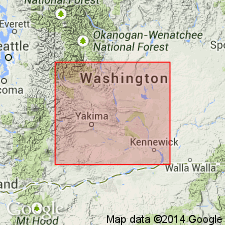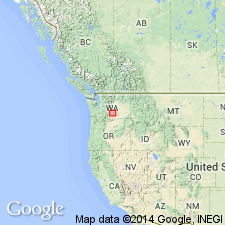
- Usage in publication:
-
- Quincy diatomite
- Modifications:
-
- Original reference
- Dominant lithology:
-
- Diatomite
- AAPG geologic province:
-
- Eastern Columbia basin
Summary:
Pg. 7-8, 25, 26, 40. Quincy diatomite in Priest Rapids Basalt Member of Yakima Basalt. In vicinity of Columbia River only one of Priest Rapids flows extended north of Frenchman Hills. Throughout western part of Quincy basin this flow rests, not directly on Roza flow (new) but on widespread sheet of diatomite, as much as 20 feet thick, here designated Quincy diatomite. Diatomite bed extends southward across axial part of Frenchman Hills anticline, terminating on its south flank. Age is Miocene.
Named for occurrence in Quincy basin, south-central WA.
Source: US geologic names lexicon (USGS Bull. 1350, p. 607).

- Usage in publication:
-
- Quincy Diatomite Bed*
- Modifications:
-
- Principal reference
- Revised
- Adopted
- Dominant lithology:
-
- Diatomite
- AAPG geologic province:
-
- Eastern Columbia basin
Summary:
Pg. G3 (fig. 1), G10. Quincy Diatomite Bed of Priest Rapids Member of Yakima Basalt of Columbia River Group. Diatomite as thick as 35 feet; contains a few lenses of silt and clay. Overlies Roza Member of Yakima Basalt. Age is late Miocene. Adopted by the USGS.
Type area: area of many quarry exposures in southwestern part of Quincy basin near head of Frenchman Springs Coulee [Frenchman Coulee], in S/2 sec. 16, SE/4 sec. 17, NE/4 sec. 20, and N/2 sec. 21, T. 18 N., R. 23 E., [Evergreen Ridge 7.5-min quadrangle, Grant Co., south-central WA].
Source: Publication; Changes in stratigraphic nomenclature, 1966 (USGS Bull. 1254-A, p. A7).

- Usage in publication:
-
- Quincy Diatomite Bed*†
- Modifications:
-
- Abandoned
Summary:
Name abandoned for two reasons. First, the diatomite is equivalent to the Squaw Creek Diatomite Bed. Second, its presumed stratigraphic position above the Roza Member [of the Wanapum Basalt of this report] and within the Priests Rapids Member [of the Wanapum Basalt of this report] is incorrect. Squaw Creek thickens westward, becomes sandstone, tuffaceous sandstone, and siltstone, and merges into, or becomes the middle member of the Ellensburg Formation of Miocene age. Name Quincy replaced by Squaw Creek [now called Lmuma Creek Member of Ellensburg Formation].
Source: GNU records (USGS DDS-6; Denver GNULEX).
For more information, please contact Nancy Stamm, Geologic Names Committee Secretary.
Asterisk (*) indicates published by U.S. Geological Survey authors.
"No current usage" (†) implies that a name has been abandoned or has fallen into disuse. Former usage and, if known, replacement name given in parentheses ( ).
Slash (/) indicates name conflicts with nomenclatural guidelines (CSN, 1933; ACSN, 1961, 1970; NACSN, 1983, 2005, 2021). May be explained within brackets ([ ]).

